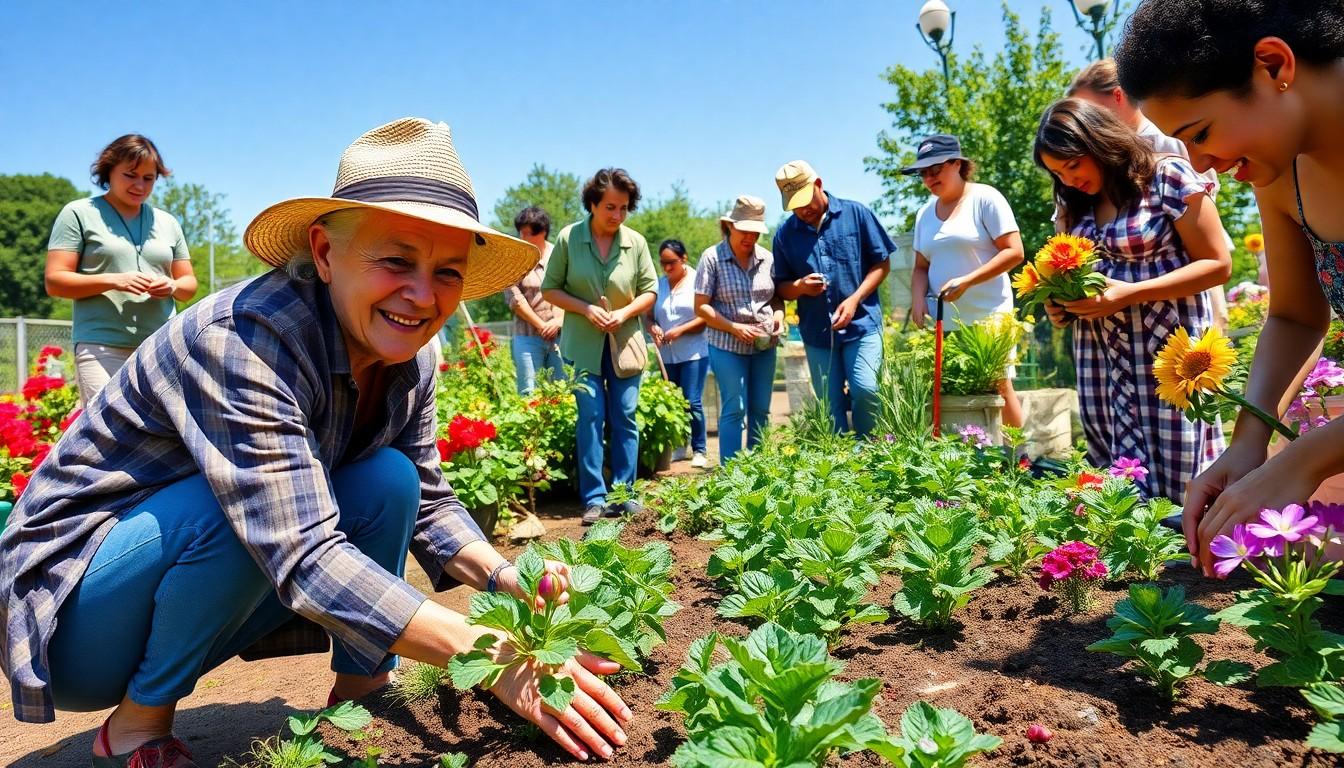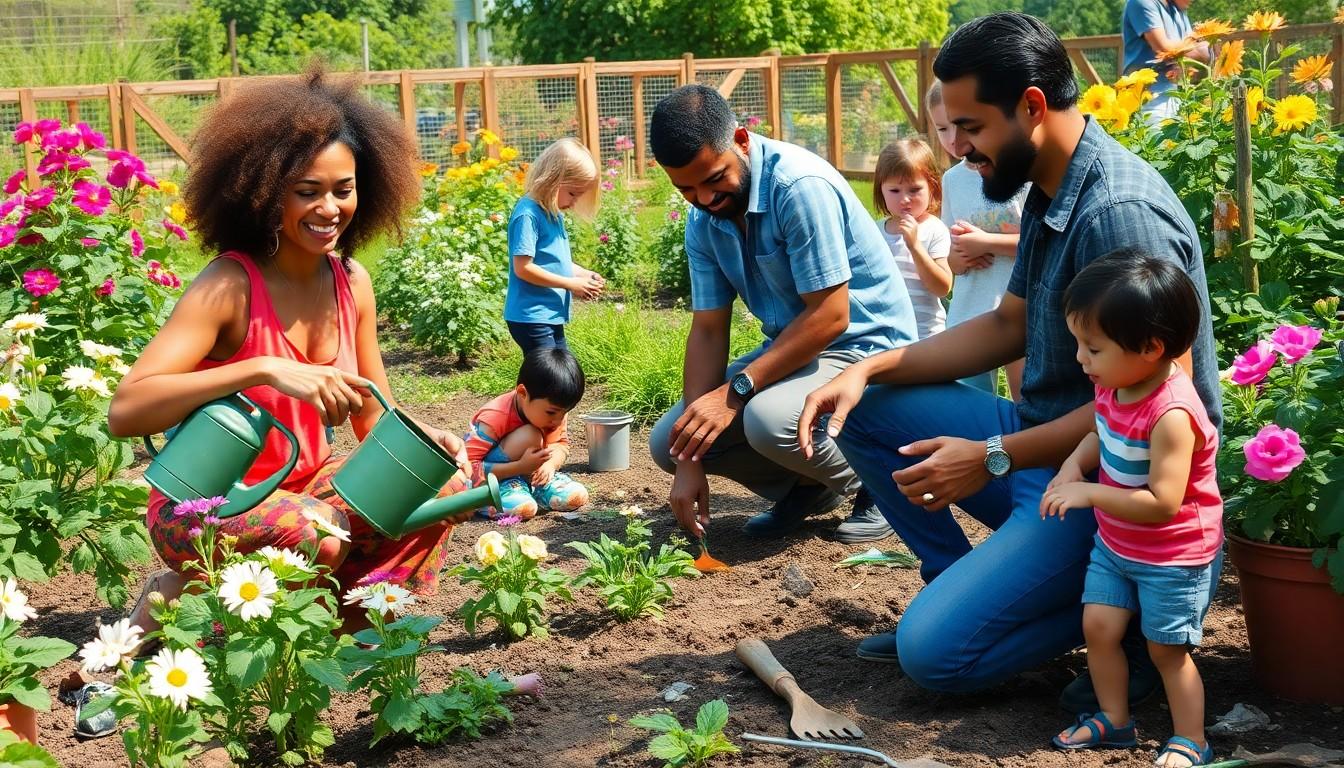Phone:
(701)814-6992
Physical address:
6296 Donnelly Plaza
Ratkeville, Bahamas.

In a world where “farm-to-table” is the latest buzzword, community gardening is the unsung hero quietly saving the planet one carrot at a time. While large-scale commercial farming churns out produce like a fast-food factory, community gardens offer a refreshing alternative that’s as local as your neighbor’s backyard. They’re not just about growing veggies; they’re about cultivating connections, sustainability, and a sense of belonging.
Community gardening plays a vital role in promoting sustainable practices and enhancing local food systems. These gardens are not just about food production; they nurture relationships and support environmental health.
Community gardening involves a group of individuals collaborating to cultivate plants on shared land. This concept dates back to the early 19th century, with origins rooted in urban areas experiencing food shortages. Such gardens emerged as a response to food insecurity, enabling communities to grow their own produce and sustainably enhance access to fresh foods. The movement gained momentum during World War I and II when victory gardens became popular across America, further solidifying the importance of community engagement in food production.
Community gardens are characterized by diverse plants, from vegetables to herbs and flowers. Participants often grow a variety of crops to promote biodiversity and encourage pollinator habitats. Gardening typically involves organic practices, minimizing chemical usage and fostering soil health. Another key aspect includes communal decision-making, allowing participants to influence garden management. These spaces also promote educational opportunities, offering workshops that teach sustainable gardening techniques to community members. Engagement extends beyond gardening, often encompassing social gatherings and community development initiatives.

Community gardening offers numerous advantages over large-scale commercial farming. It fosters sustainability through environmental and social impacts.
Soil health improves significantly with community gardening practices. Organic methods commonly used in these gardens reduce pesticide reliance, enhancing biodiversity. Water conservation techniques, such as rainwater harvesting, decrease waste and promote sustainable water use. Carbon emissions lower due to decreased transportation needs for small-scale, local produce. The cultivation of native plants also supports local ecosystems, creating habitats for wildlife. Overall, community gardens contribute to a healthier environment while promoting sustainable agriculture.
Community gardening strengthens social ties among participants. Individuals come together, fostering relationships through shared gardening experiences. A sense of belonging forms, enhancing community identity and pride. Education about sustainable practices occurs through workshops and collaborative efforts. Diverse cultural backgrounds enrich the gardening experience, creating opportunities for cultural exchange. Events organized around the gardens bring together different community members, thus promoting inclusivity. These social interactions lead to lasting friendships and connections, further solidifying community bonds.
Community gardening achieves higher sustainability compared to large-scale commercial farming through efficient resource use and biodiversity preservation.
Community gardens utilize local resources, reducing reliance on external inputs. These gardens encourage composting, which minimizes waste and supports healthy soil. Smaller plots enable better management of water resources, often using rainwater harvesting techniques. By sourcing seeds and plants locally, transportation costs decrease, leading to lower carbon footprints. They demonstrate a model of circular economy by promoting cooperative resource sharing, further enhancing efficiency and sustainability.
Biodiversity thrives in community gardens, where varied plant species coexist. The presence of diverse crops attracts beneficial insects, which naturally controls pests, reducing chemical usage. Unlike monoculture practices in commercial farming, community gardens prioritize a mix of flora. Native plant cultivation supports local wildlife, contributing to healthier ecosystems. By fostering a rich variety of plants, these gardens enhance resilience against diseases and climate fluctuations. This approach not only preserves biodiversity but also strengthens local food systems, ensuring sustainable practices.
Large-scale commercial farming faces significant challenges that impact sustainability. Environmental degradation and economic concerns arise as primary issues in this agricultural model.
One major issue linked to large-scale commercial farming is environmental degradation. Intensive farming practices degrade soil quality, leading to erosion and nutrient depletion. Water pollution occurs due to runoff from fertilizers and pesticides, which contaminates local waterways. Loss of biodiversity is evident as monoculture practices dominate, harming ecosystem stability. In many cases, habitat destruction results from the expansion of farmland, threatening wildlife populations. Climate change further complicates matters, as large farms contribute to greenhouse gas emissions through fossil fuel reliance and land conversion.
Economic concerns also plague large-scale commercial farming. The reliance on expensive inputs such as synthetic fertilizers, pesticides, and fuel creates significant financial burdens for farmers. Market fluctuations pose risks, impacting profits and sustainability. Many small farmers struggle to compete with corporate agribusinesses, leading to decreased community resilience. Labor exploitation often occurs, with some farms cutting costs by paying inadequate wages. Long-term dependency on governmental subsidies can further destabilize the agricultural economy, affecting sustainability and food security.
Community gardening represents a promising path toward sustainable agriculture. This approach not only safeguards local ecosystems but also enhances nutritional security.
Integrating community gardens into urban planning encourages food sovereignty. Local leaders can designate spaces for these gardens, promoting access for all residents. Partnerships with schools can enhance educational opportunities on sustainable practices. Incorporating community gardens into existing parks fosters biodiversity while providing fresh produce. Local farmers’ markets can partner with gardens to create efficient food distribution channels. Community involvement is essential for maintaining these gardens, creating ownership among participants. Engaging local residents ensures these gardens thrive and adapt to the community’s needs.
Policy recommendations can transform the landscape of community gardening. Local governments should incentivize land use for community gardens through grants and tax breaks. Zoning laws might need modification to allow for garden installations in various neighborhoods. Expanding access to resources, such as seeds and tools, supports garden development. Programs should promote collaboration among community groups to share knowledge and resources. Policies that prioritize organic practices can encourage sustainable farming methods within these gardens. Robust support networks for community gardeners will bolster their impact on local food systems.
Community gardening stands out as a beacon of sustainability in contrast to large-scale commercial farming. By prioritizing local engagement and biodiversity, these gardens create resilient food systems that benefit both the environment and community members. They foster connections that strengthen social ties while promoting eco-friendly practices that protect natural resources.
As urban areas continue to grow, integrating community gardens into city planning can enhance food sovereignty and nutritional security. Supporting these initiatives not only enriches local ecosystems but also cultivates a sense of belonging among participants. Embracing community gardening paves the way for a more sustainable and connected future.